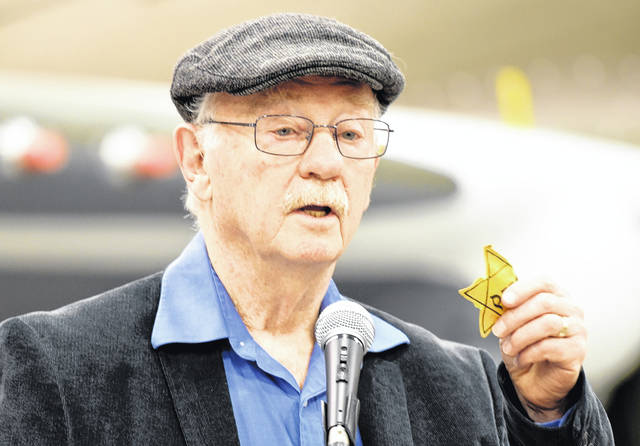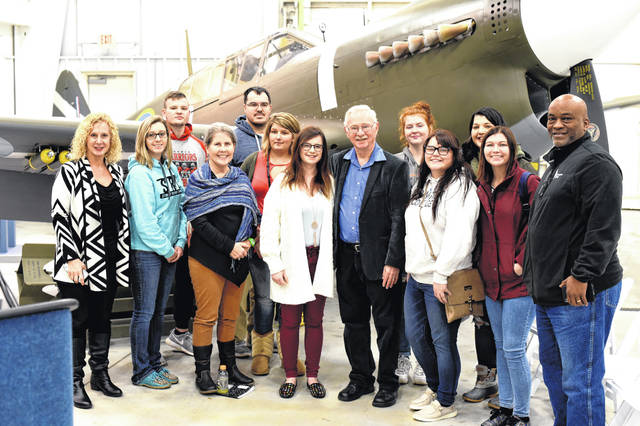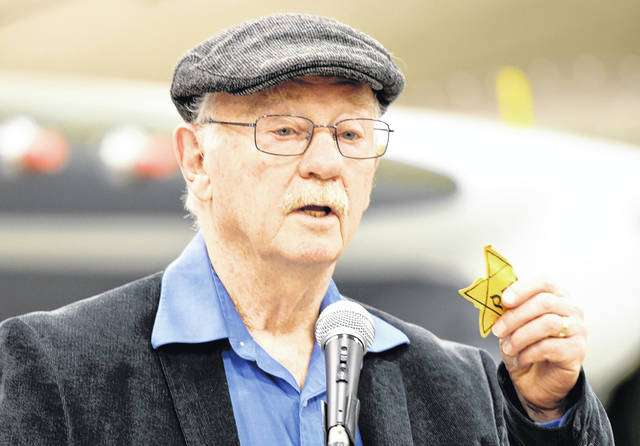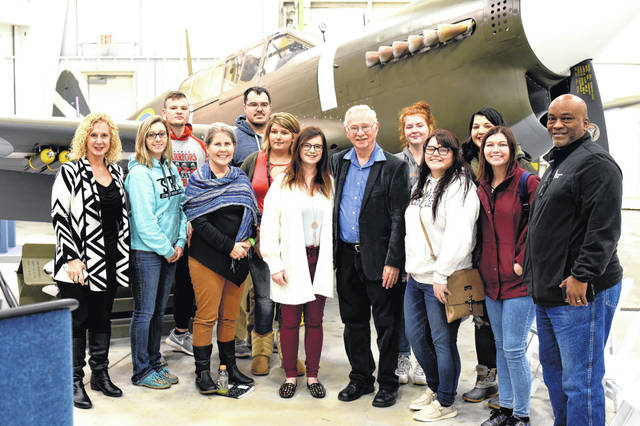



Eighty-two-year-old Henry Fenichel held up a yellow Star of David featuring the Dutch word for Jew — Jood. Nearly 80 years ago, the Nazis pinned that on his shirt with orders for him to display it every day and everywhere.
Fenichel shared his incredible journey as a Jewish Holocaust survivor at a forum Saturday (Jan. 18) that included two-dozen Wilmington College students visiting the Tri-State Warbird Museum in Batavia. He titled his presentation “The Story of a Star Child.”
The program coincided with this month’s 75th anniversary of the Allies’ liberation of the Nazi death camp, Auschwitz-Birkenau. Some 11 million persons perished in Nazi camps, including 6 million Jews, 1.2 of whom were children. Fenichel warned his audience against being complacent in the face of any hate-filled ideology or actions, whether or not attacks are directed toward persons of another race, ethnicity or orientation than themselves.
“Not all Germans were Nazis, but too many German bystanders allowed the Nazis to do what they did — don’t be a bystander!” he said.
Dr. Marlaina Leppert-Wahl, associate professor of political science, took students from her sociology and global issues classes to Batavia for a guided tour of the museum featuring restored World War II airplanes followed with a lecture by the emeritus physicist from the University of Cincinnati.
Fenichel hearkened May 1940 when “all hell broke loose and life changed” for the four-year-old and his parents. The Nazis had invaded the Netherlands. Their takeover was both incremental and insidious. First, the neighborhood policeman was no longer Dutch — he was German.
Then restrictions of movement were implemented, identification cards were issued highlighting a large “J” for Jews and later all Jewish men — including his father — were taken away “to assist the war effort” in work camps.
“A year (after the invasion), we had to wear that special star,” he added.
When the Nazis began rounding up the Jewish women and children, Fenichel and his mother sought sanctuary at an infirmary in their city, The Hague. They eventually were discovered and taken to Westerbork, a transit detention camp near the Dutch-German border. There, they learned his father perished at Auschwitz.
Meanwhile, the family applied for an exchange program in which Christian Germans, whose ancestors had settled in Palestine dating back to the 1800s, who wished to return to Germany were “exchanged” for European Jews. The arrangement was facilitated by the British, which then controlled Palestine. While the
Fenichels attained the proper certification in late 1943, they were not immediately selected and, in February 1944, were taken from Westerbork to Bergen-Belsen Concentration Camp in Germany.
“This was no summer camp. It was more like a kennel than a camp with all its fences,” he said, adding that while tens of thousands (including Anne Frank) died at Bergen-Belsen, primarily from illness and disease, it was not a death camp per se like the notorious Auschwitz.
However, trains arrived regularly to transport 1,000 prisoners each day from Bergen-Belsen to the Nazi death camps.
Throughout this terrifying ordeal, Fenichel said his mother kept the young boy calm and sheltered from the horrors around them in much the same way as depicted in the 1997 film, Life Is Beautiful, in which the prisoner father convinces his young son that life in the concentration camp is a game in which everyone is merely playing a role.
After six months surviving on soup and bread at Bergen-Belsen, they, miraculously, were among 222 Dutch Jews allowed to emigrate to Palestine. They were loaded onto a train bound for Turkey, where a ferry transported them to the Holy Land.
Upon arrival, they were split up with young Henry sent to a children’s home. Fortunately, his mother was able to visit him frequently.
Following Israel’s war for independence in 1948, he was reunited with his mother in Tel Aviv, where she had remarried. His stepfather’s brothers in the United States urged them come to America, saying. “The streets are paved in gold.”
The three of them traveled on the ill-fated Italian ship, Andrea Doria, landing in the U.S. in January 1953.
“We arrived in New York Harbor,” Fenichel excitedly recalled. “That was my welcome to this great country!”
The family lived in Brooklyn and he graduated from Brooklyn College and earned a Ph.D. in physics from Rutgers University. In 1965, Fenichel joined the faculty at the University of Cincinnati, where he taught physics and conducted research until his retirement.
He married and had two daughters and now grandchildren. Upon his stepfather’s death, his mother joined them in the “incredible community” of Cincinnati, where she happily lived out the remainder of her life.
“I found out the streets in America really are paved in gold!”
Leppert-Wahl said opportunities to hear directly from Holocaust survivors are rapidly dwindling and their Saturday venture was a great hands-on learning experience for her students.
“Those personal stories touch people in a way that simply hearing ‘6 million Jews’ cannot do,” she said, noting the State of Israel is discussed significantly in her global issues course that has a Middle Eastern theme. “The Holocaust is central to the Jewish people.”
Also, World War II was a defining experience for the American people and learning about period airplanes that helped win the war — and hearing a Holocaust survivor — “give us an initial or enhanced appreciation” of that
part of history, she added. “World War II is so closely identified with the so-called Greatest Generation. It colors Americans as a people and their role as defenders of freedom.”
Sophomore Brittanie Clair greatly appreciated hearing Fenichel’s story. “It’s amazing and it hits home for me,” she said. “My grandparents were part of the Holocaust. It’s important to learn more than from the history books.”
Another sophomore, DeLanie Weber, concurred that, “Not a lot of people my age have the opportunity to hear from a living Holocaust survivor. I also liked that the World War II planes were part of the trip.”



